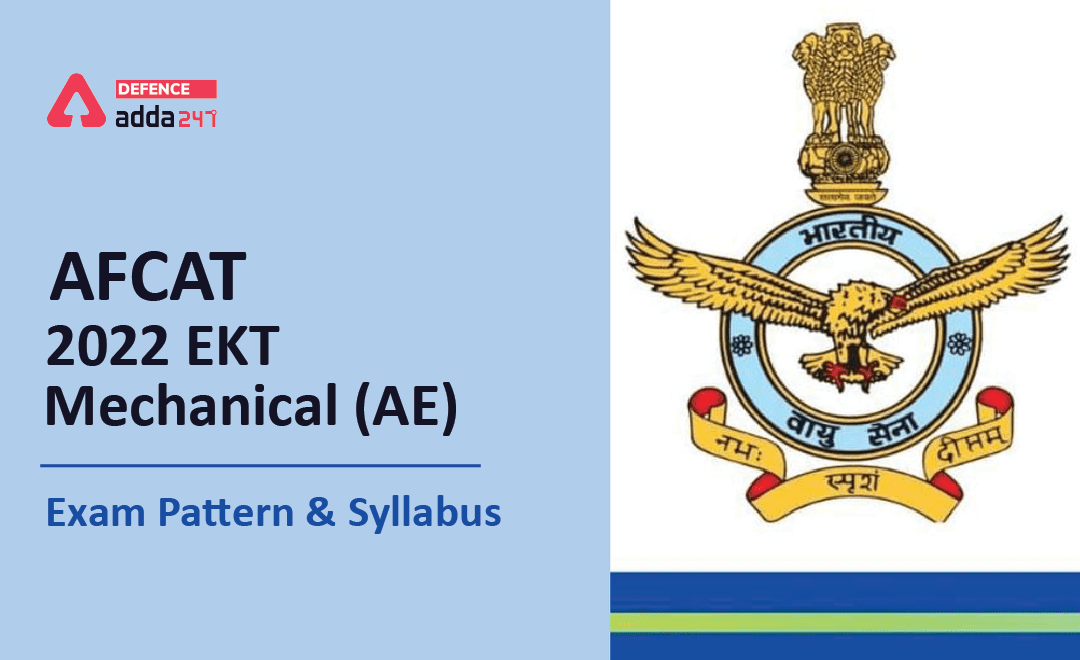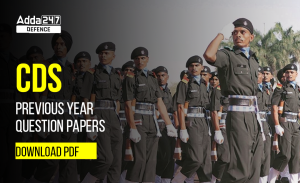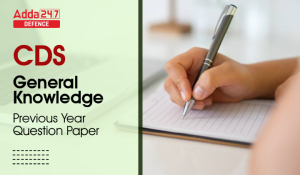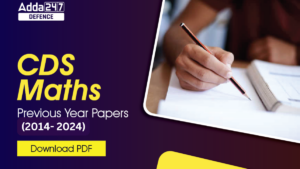AFCAT EKT Mechanical Syllabus & Exam Pattern 2022
As we already know that Indian Air Force has invited online applications for the courses commencing in July 2022 for grant of Short Service Commission (SSC) in Flying Branch and Permanent Commission (PC) and Short Service Commission (SSC) in Ground Duty (Technical and Non-Technical) Branches.
Online Application Link for AFCAT I 2022
Last Date to Apply Online: 30th December 2021
AFCAT 1 2022 Exam Date: 12th, 13th, and 14th February 2022
AFCAT 1 2022 EKT Exam Pattern
Air Force Common Admission Test commonly known as AFCAT is a common entrance examination organized by Indian Air Force to select eligible cadets for multiple posts in Ground Duty and Flying Branch. AFCAT is conducted twice every year and millions of students appear in the examination to become part of prestigious organisation.
The conducting body has divided the AFCAT selection process 2021 into three phases –
- AFCAT Online Exam for all candidates
- EKT (for Technical candidates)
- AFSB Interview
- Final Selection after Medical Examination.
| Exam |
Subject |
Duration |
No. of questions |
Max. marks |
| AFCAT |
General Awareness, Verbal ability in English, Numerical ability and reasoning and military aptitude test |
02 Hours |
100 |
300 |
| EKT(for Ground Duty technical branch only) |
Mechanical, computer science and electrical &electronics |
45 Minutes |
50 |
150 |
The EKT exam is Engineer knowledge test. This test is only for candidates who opt for Ground duty technical branch. Candidates will be given 45 minutes to solve 50 questions in the EKT test. The maximum marks allotted to the exam are 150. The EKT test will carry questions from Mechanical, Computer Science and Electrical & Electronics.
AFCAT EKT Mechanical Syllabus
| Fundamental Engineering syllabus |
- Engineering Physics
- Engineering Mathematics
- Engineering Drawing/ Engineering Graphics
|
| Specialised Branch topics |
- Thermodynamics
- Fluid Mechanics/Hydraulic Machines
- Engineering Mechanics
- Materials Science
- Thermodynamics
- Manufacturing Science
- Machine Drawing
|
| Allied Engineering Topics |
- Aerodynamics
- Flight Mechanics
- Aircraft Structures
- Power Plant Engineering.
- Industrial Engineering
- Automotive Engineering
|
Fundamental Engineering
1. Engineering Mathematics. Matrix Algebra, Eigen values and Eigen vectors, Theorems of integral calculus, Partial derivatives, Maxima and minima, Multiple integrals, Stokes, Gauss and Green’s theorems. First order differential equation (linear and nonlinear), Cauchy’s and Euler’s equations, Complex variables, Taylor’s and Laurent’ series, Sampling theorems, Mean, Median, Mode and Standard deviation, Random variables, Discrete and Continuous distributions, Fourier transform, Laplace transform, Ztransform.
2. Engineering Physics. Units for measurement, Description of Motion in One, Two and Three dimensions, Laws of Motion, Work, Energy and Power, Rotational Motion, Gravitation, Heat and Thermodynamics, Electrostatics, Electric Current, Magnetic Effect of Currents, Magnetism, Electromagnetic Induction and Alternating Currents and Electromagnetic Waves, Ray Optics and Optical Instruments.
3. Engineering Graphics/Engineering Drawing. Principles of orthographic projections, projections of points, lines, planes and solids, Section of solids, Isometric views, Auto-CAD.
Specialization Branch Topics
4. Engineering Mechanics. Equations of equilibrium in space and its application; first and second moments of area; simple problems on friction; kinematics of particles for plane motion; elementary particle dynamics. Generalized Hooke’s law and its application; design problems on axial stress, shear stress and bearing stress; material properties for dynamic loading; bending shear and stresses in beams; determination of principle stresses and strains – analytical and graphical; material behaviour and design factors for dynamic load; design of circular shafts for bending and torsional load only; deflection of beam for statically determinate problems; theories of failure.
5. Thermodynamics. Basic concept of First –law and second law of Thermodynamics; concept of entropy and reversibility; availability and unavailability and irreversibility. Classification and properties of fluids; incompressible and compressible fluids flows; effect of Mach number and compressibility; continuity momentum and energy equations; normal and oblique shocks; one dimensional isentropic flow; flow or fluids in duct with frictions that transfer. Flow through fans, blowers and compressors; axial and centrifugal flow configuration; design of fans and compressors
6. Theory of Machines. Kinematic and dynamic analysis of plane mechanisms. Cams, Gears and epicyclic gear trains, flywheels, governors, balancing of rigid rotors, balancing of single and multicylinder engines, linear vibration analysis of mechanical systems (single degree of freedom), Critical speeds and whirling of shafts. flywheels, balancing of rotors and reciprocating machinery, balancing machines, governors, free and forced vibration of damped and undamped single degree of freedom systems, isolation, whirling of shafts, gyroscope.
7. Fluid mechanics/Hydraulic Machines. Fluid flow concepts – Transport theorem – Fluid kinematics – Potential flow – Governing equations of Fluid flow – Dimensional Analysis – Viscous flow – Boundary Layer flows – Turbulence – Closed conduit flows – Hydrodynamic lubrication – Free surface flow – Compressible flows, Hydraulic Turbines: Impulse and Reaction Turbines – Centrifugal and Axial flow pumps.
8. Manufacturing Science. Foundry Technology, Melting furnaces, Special casting processes, Gating and riser design, Casting defects, Arc welding, TIG, MIG, submerged arc, resistance welding, Gas welding, Flash butt welding, Solid state welding, Welding metallurgy, Forming Technology, Powder metallurgy.
9. Materials Science. Basic concepts on structure of solids; common ferrous and nonferrous materials and their applications; heat-treatment of steels; non-metals- plastics, ceramics, composite materials and nano-materials.
10. Machine Drawing. Development and Intersection of surfaces, Conventional representation of machine elements, materials, surface finish and tolerances – Sectional views and additional views – Drawing of Screw threads, locking devices, Fasteners, Keys and Cotters, Knuckle joints, Riveted Joints, Shaft Couplings and Bearings – Pipe Joints, Assembly and production drawings.
Allied Engineering
11. Automotive Engineering. Introduction, power plant, fuel system, electrical system and other electrical fittings, lubricating system and cooling systems, chassis and transmission, axles, clutches, propeller shafts and differential, Condition for correct steering, steering gear mechanisms, automotive air conditioning, Tyres, effect of working parameters on knocking, reduction of knocking; Forms of combustion chamber for SI and CI engines; rating of fuels; additives; emission.
12. Power Plant Engineering. Steam power plant, steam boilers, steam condensers, cooling towers, cogeneration and combined cycles, nuclear power plants, hydroelectric power plants, power plant economics.
13. Industrial Engineering. System design: factory location- simple OR models; plant layout – methods based; applications of engineering economic analysis and break- even analysis for product selection, process selection and capacity planning; predetermined time standards. System planning; forecasting methods based on regression and decomposition, design and balancing of multi model and stochastic assembly lines; inventory management – probabilistic inventory models for order time and order quantity determination; JIT systems; strategic sourcing; managing inter plant logistics.
14. Flight Mechanics. Atmosphere: Properties, standard atmosphere. Classification of aircraft. Airplane (fixed wing aircraft) configuration and various parts. Airplane performance: Pressure altitude; equivalent, calibrated, indicated air speeds; Primary flight instruments: Altimeter, ASI, VSI, Turn-bank indicator. Drag polar; takeoff and landing; steady climb & descent,-absolute and service ceiling; cruise, cruise climb, endurance or loiter; load factor, turning flight, V-n diagram; Winds: head, tail & cross winds. Static stability: Angle of attack, sideslip; roll, pitch & yaw controls; longitudinal stick fixed & free stability, horizontal tail position and size; directional stability
15. Aircraft Structures. Stress and Strain: Equations of equilibrium, constitutive law, strain displacement relationship, compatibility equations, plane stress and strain, Airy’s stress function. Flight Vehicle Structures: Characteristics of aircraft structures and materials, torsion, bending and flexural shear. Flexural shear flow in thin-walle sections. Buckling. Failure theories. Loads on aircraft. Structural Dynamics: Free and forced vibration of discrete systems. Damping and resonance. Dynamics of continuous systems.
16. Aerodynamics. Basic Fluid Mechanics: Incompressible irrotational flow, Helmholtz and Kelvin theorem, singularities and superposition, viscous flows, boundary layer on a flat plate. Airfoils and wings: Classification of airfoils, aerodynamic characteristics, high lift devices, Kutta Joukowski theorem; lift generation; thin airfoil theory; wing theory; induced drag; qualitative treatment of low aspect ratio wings. Viscous Flows: Flow separation, introduction to turbulence, transition, structure of a turbulent boundary layer. Compressible Flows: Dynamics and Thermodynamics of I-D flow, isentropic flow, normal shock, oblique shock.
In order to holistically cover this syllabus, Adda247 has launched the “Mission AFCAT Batch”.
The Aim of this Batch is to help students learn and understand the new pattern of exams which will help them to maximize their scores in the competitive examination. The batch will be taken by experienced faculties, subject-matter experts and with the expertise of Adda247 keeping the new pattern and challenges of competitive exams in mind.
Click Here: Complete AFCAT EKT Syllabus



 CDS Previous Year Question Papers, Downl...
CDS Previous Year Question Papers, Downl...
 Last 11 years CDS General Knowledge Prev...
Last 11 years CDS General Knowledge Prev...
 Last 11 Years CDS Mathematics Previous Y...
Last 11 Years CDS Mathematics Previous Y...
